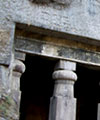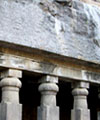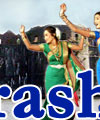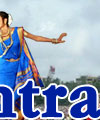|
Traditional Crafts
A region as large and diverse as Maharashtra in terms of culture, customs and geography is bound to develop rich repertoire of art and techniques of artistic crafts. Maharashtra is the proud home to various different artistic techniques, which have flourished under the many rulers including the Marathas, the Mughals and the British. From the paintings at Ajanta, so many hundreds of years ago, to today's Warli paintings, Maharashtra's ties with the Arts have always remained strong and nurturing.
Bidri Ware
Bidri ware, one of Aurangabad's ancient crafts, employs zinc and copper as
raw materials. It usually involves intricate workmanship of pure silver, either
embossed, overlaid or inlaid on the metal surface. Originally, Bidri ware items
were used as hookahs or paan daans but they have been relegated to as souvenirs.
Paithani Saris
The art of weaving Paithani saris is believed to be 2000 years old.
The yarn used is pure silk and the zari or gold threads are drawn
from pure gold. A heavily brocaded Paithani sari takes anywhere from
six months to one and a half years to weave.
Sawantwadi Crafts
Sawantwadi crafts or the style of paintings and varnishing using lacquer
appear to have originated from Sawantwadi around the end of the 17th and
the beginning of the 18th century. Lacquer ware can be broadly divided into
three categories. Firstly, turned lacquer ware, which is the craft of applying
colored lacquer on an object, which is turning on a lathe, and then polishing
and buffing it by means of a kewda leaf. Secondly, painting of floral borders
and motifs on surfaces of objects and thirdly, the painting of mythological
figures on various surfaces. Sawantwadi lacquer ware has a large range of products
and concentrates on traditional hand painted and lacquered furniture and light
fittings. Ganjifa card games, which were played and made in the 18th and 19th
centuries, are produced in all varieties and can be found in private collections
and in museums.
Warli Paintings
Warli paintings are the indigenous paintings of the Warli tribe
who live in the Thane district north of Mumbai. The craft is
traditionally practiced by the womenfolk of the tribe, who made
used of the paintings or chawk during wedding rituals. The sacred
pictographs used rice paste and straw, which was then smeared on
the walls of their modest huts. The main figure was of Palghat,
the goddess of trees and plants, symbolizing creative energy. These
days, even young men have taken to painting and they are often done
on paper incorporating traditional decorative Warli motifs with
modern elements as well such as the bicycle, etc. Warli paintings
on paper have become very popular and are now sold all over India.
Kolhapuri Chappals
Kolhapur , besides being known for its textiles and cottons it is also famous
for its hand-made leather sandals or chappals. These leather sandals made in
simple style but finished with great perfection are very popular the world over.
The cost depends on the quality of leather and design, but in general Kolhapuri
chappals are reasonable and good value for money.
Narayan Peth
A traditional Maharashtrian sari usually from around Sholapur, the Narayan Peth
sari is beautifully woven in silk with a contrasting zari border, generally with
'rudraksha' motifs.
Leather Works
The hand made leather sandals or chappals of Kolhapur are famous all over
the world. They are popular for their simple styles and comfort. The cost
of the these sandals and chappals may differ depending upon the quality of
leather and designs used. They are definitely worth buying.
Weaving
Maharashtra is also known for its strong textile history. There are different
types of saris or materials available belonging to a particular area or region
of the state, such as Kolhapur, Pune and Paithan, Aurangabad.
Mashru and Himru
Aurangabad is famous for Mashru and Himru fabrics. These two types of fabrics
are made of cotton and silk having a shine like satin. Himru shawls are less
expensive and are made by using both silk and cotton threads. These threads help
in producing beautiful multi-colored designs on these shawls. The actual ornamental
design is formed on the principle of extra weft figuring. The extra silk weft left
loose makes the Himru shawl soft, which almost feels like silk. Weavers were brought
to Aurangabad from Banaras and Ahmedabad by Mohamed-bin-Tughlak and thus the Himru
industry started.
Ajanta Paintings
The paintings in Ajanta Caves are outstandingly beautiful, they belong to the
diffused art style of China & Japan. The Ajanta paintings were painted by the Buddhist
Monks who turned the stone walls into picture books of Buddha's life & teachings.
These Buddhist artists have portrayed the costumes, ornaments & styles of the
court life of their times.
Top
Information on Traditional Crafts, arts, handicrafts of Maharastra - India
|






